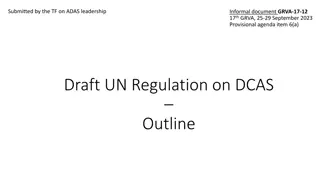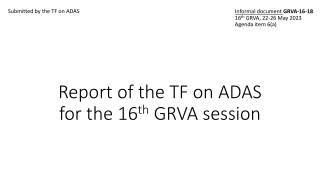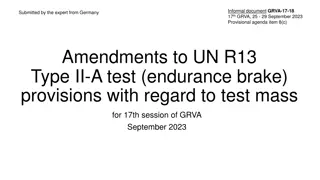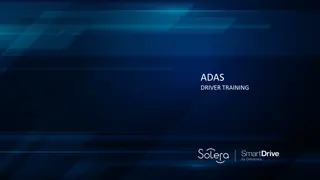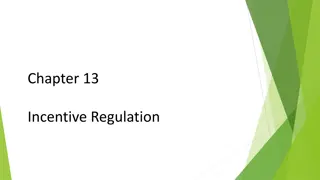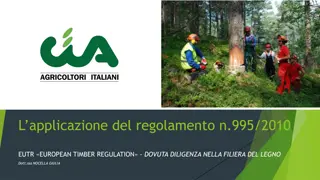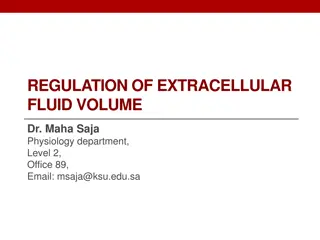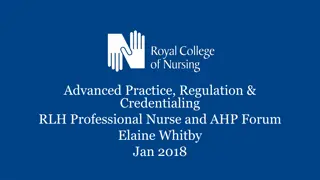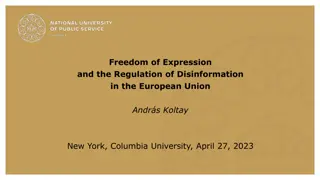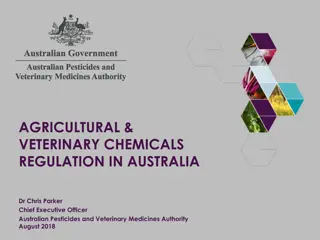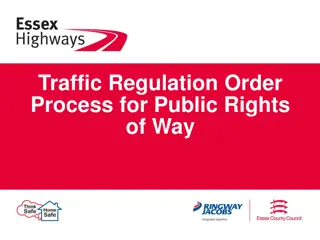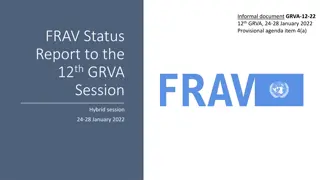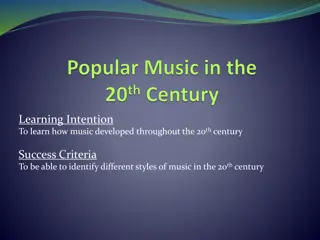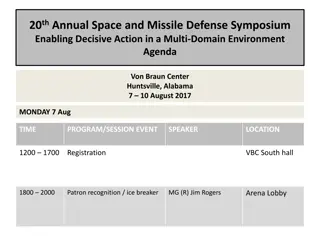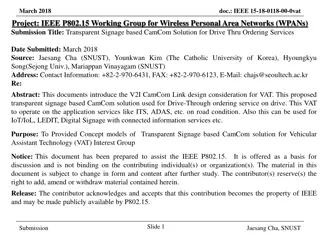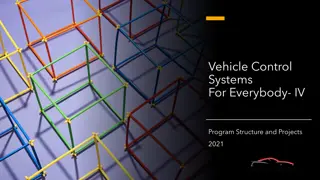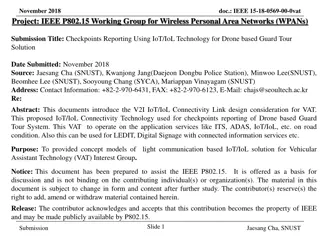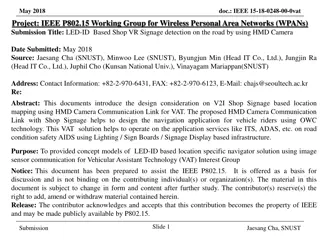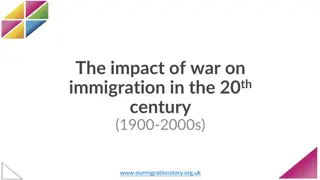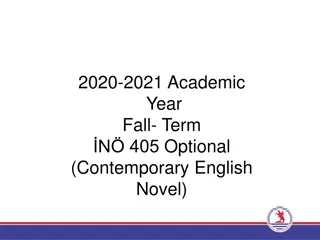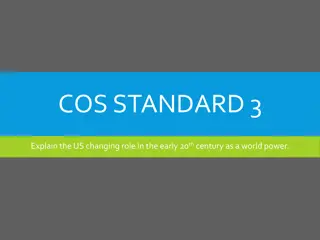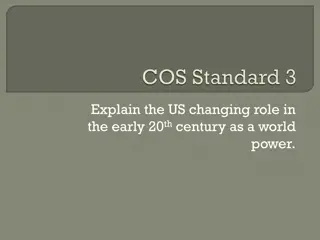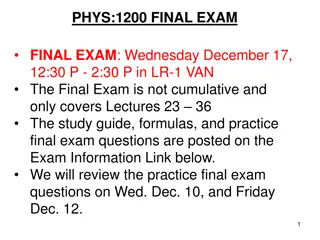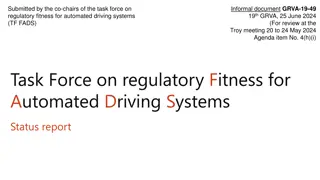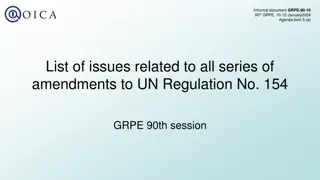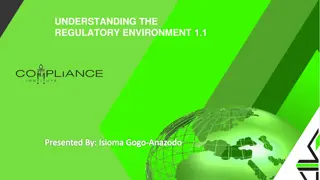Development of ADAS UN Regulation for 20th GRVA Session
The TF on ADAS has been actively working on drafting the DCAS UN Regulation through various meetings and revisions. The status after the 18th GRVA session shows progress in resolving issues and textual improvements. The next steps involve further development in Phase 2, focusing on system-initiated maneuvers and driver disengagement monitoring. The workplan includes online and in-person meetings leading up to the submission of the working document in September 2024.
Download Presentation

Please find below an Image/Link to download the presentation.
The content on the website is provided AS IS for your information and personal use only. It may not be sold, licensed, or shared on other websites without obtaining consent from the author. Download presentation by click this link. If you encounter any issues during the download, it is possible that the publisher has removed the file from their server.
E N D
Presentation Transcript
Submitted by the TF on ADAS Informal document GRVA-18-16 18thGRVA, 22-26 January 2024 Provisional agenda item 6(a) Report of the TF on ADAS for the 18thGRVA session
Status after the 18thGRVA session Hybrid meeting (Brussels, 23-27 October 2023) Four online meetings (5 October 2023, 29 November 2023, 8 December 2023, 15 January 2024) Two online meetings of the Small Drafting Group The draft DCAS UN Regulation is in the agenda of the 18thGRVA session Working document ECE/TRANS/WP.29/GRVA/2024/2 agreed by the ADAS TF at the Brussels session (Eight pairs of square brackets remained) Informal document GRVA-18-07 amending ECE/TRANS/WP.29/GRVA/2024/2 agreed by ADAS TF at the November and December sessions, resolving all issues with square brackets plus textual improvements. Available since mid-December Informal document GRVA-18-07-Rev.1 amending GRVA-18-07 incorporating textual and requirement consistency improvements agreed by ADAS TF at the January session Corresponding draft amendments to UN Regulation No. 79 to segregate its scope and the scope of the DCAS UN Regulation in the agenda of the 18thGRVA session Working document ECE/TRANS/WP.29/GRVA/2024/12 submitted by D, EC, F, NL and UK Informal document GRVA-18-14 amending ECE/TRANS/WP.29/GRVA/2024/12 agreed by the ADAS TF at its January session Additional reference informal document GRVA-18-15 providing an overview of the changes to ECE/TRANS/WP.29/GRVA/2024/12 Link to the ADAS TF documents: https://wiki.unece.org/display/trans/ADAS 2
DCAS UN Regulation Drafting Process 14 GRVA Sep. 22 Draft 1 18 GRVA Jan. 24 Draft 3 (final) 16 GRVA May 23 20 ADAS TF 15 May 23 Draft 2 = ADAS-20-02 Interim 14 ADAS TF 30 Aug. 22 Draft 1 = ADAS-14-02 ECE/TRANS/WP.29/GRVA/2024/2 + GRVA-18-07 We are here Stage 3 Stage 1 Stage 2 Stage 1 overview and restructuring identify issues (redundancies, contradiction with principles, interpretation ) to be solved on the Stage 2 Stage 2 detailed review agree on content of the requirements Stage 3 fine tuning finalize wording and definitions 3
Next steps Further development of the DCAS UN Regulation - Phase 2, to address: System-initiated manoeuvres (lane changes and other) Driver disengagement monitoring by means of assessment of visual disengagement only (realization of the Hands-off technology) Background: FKA hands-off study Provisions for automated lane changes established in UN-R157 that could serve as blueprint for system initiated lane changes Existing multi-pillar assessment in DCAS Experience with the indicated features in non-UNECE markets Workplan after the 18thGRVA session: Several online meetings of the ADAS TF upon availability of proposals Long in-person (hybrid) meeting [in Brussels] in April/May 2024 Target to submit the working document to the 20thGRVA session in September 2024 4
Introduction of the draft UN Regulation on DCAS Working document ECE/TRANS/WP.29/GRVA/2024/2 Informal document GRVA-18-07 Informal document GRVA-18-07-Rev.1 5
Specific changes introduced by GRVA-18-07 (1/2) Agreed definitions (2.) Series of manoeuvres can be considered as one manoeuvre (2.10.) Specified mandatory systems on a DCAS-equipped vehicle: AEBS plus either Lane Departure Prevention System (CSF) of LDWS per UN R 131, 152, 79 (CSF) and 130 as appropriate per vehicle category (5.1.5.) Conditions for the initiation of a manoeuvre (5.3.7.2.1.1.) Optimizing provisions for the Speed Limit Compliance Assistance (5.3.7.4.) Stand-by mode of operation is divided to Inactive (DCAS outside system boundaries) and Passive (DCAS within system boundaries) modes of operation for the purpose of ISMR (2.18, 5.5.1.) 6
Specific changes introduced by GRVA-18-07 (2/2) If the system is no longer permitted to provide assistance, the manufacturer shall implement strategies to ensure controllability of these phases of operation (5.5.3.4.1.5.) The manufacturer shall implement strategies to address the detection and response to multiple subsequent short aversions of eye gaze or head posture by the driver (5.5.4.2.5.3.) Optimized timing of driver alerts in case of his/her disengagement (5.5.4.2.6.2.3. deleted) Conditions for navigating around an obstruction in the lane of travel (6.3.9.1., 6.3.9.3.) Editorial amendments to improve English language 7
Specific changes introduced by GRVA-18-07-Rev.1 Textual & requirements consistency improvements to: o 5.3.2.3. o 5.3.7.2.1.1. o 5.4.2.1. o 5.5.2.2. o 5.5.3.1. o 5.5.3.3.3. o 5.5.3.4.1.5. o 5.5.4.1.1 o 5.5.4.2.3.1.2. o 5.5.4.2.5.2. 8
General overview of the draft DCAS UN Regulation (changes introduced in GRVA-18-07) DCAS is a system comprising of a number of features Operation modes: Active Stand-by Off DCAS Feature 1 Lane Positioning & longitudinal control Feature 2 - (e.g., driver- confirmed lane change) Feature 3 - (e.g., driver- Initiated lane change) Etc. 5. General Specifications (Applicable to all DCAS) 5.1. General requirements 5.2. DCAS interaction with other assistance systems 5.3. Functional requirements 5.4. System safety response to detected failures 5.5. HMI 5.6. Driver information materials 6. Additional specifications for DCAS features 6.1. Specific requirements for positioning in the lane of travel 6.3. Specific requirements for other manoeuvres 6.2. Specific requirements for lane changes 9
Section 5 5.3. Functional Requirements 5.3.1. System detection capabilities to be described by the manufacturer 5.3.2. The system shall be able to assess and respond to its surroundings according to its functionality, within the system boundaries 5.3.3. The system may activate relevant vehicle systems when necessary (e.g., direction indicators) 5.3.4. The manufacturer s control strategy shall be designed to reduce the risk of collision whilst remaining controllable accounting for the reaction time of the driver 5.3.5. Response to system boundaries 5.3.6. Controllability 10
Section 5 5.3. Functional Requirements (cont-d) 5.3.7. System dynamic control 5.3.7. System Dynamic Control 5.3.7.1. Positioning of the vehicle in the lane of travel 5.3.7.2. Manoeuvre 5.3.7.2.1. General requirements 5.3.7.2.2. General requirements for driver- initiated manoeuvres 5.3.7.2.3. General requirements for driver- confirmed manoeuvres 5.3.7.2.4. General requirements for system-initiated manoeuvres (Reserved) 5.3.7.3. Driver Unavailability Response 5.3.7.4. Speed Limit Compliance Assistance 5.3.7.5. Safe Headway Assistance 5.3.8. Longitudinal control 5.3.8.1. Deceleration and acceleration 5.3.8.2. Speed limit compliance assistance 5.3.8.3. Safe headway assistance 11
Section 5 5.5. HMI 5.5.1. System modes of operation 5.5.2. General requirements 5.5.3. Activation, deactivation, driver override) 5.5.4.2.1. Driver disengagement monitoring 5.5.4.2.2. General requirements for driver disengagement warnings 5.5.4.2.3. Types of warnings 5.5.4.2.4. Assessment of motoric disengagement 5.5.4.2.5. Assessment of visual disengagement 5.5.4.2.6. Warning escalation sequence 5.5.4.2.7. Additional Strategies for Disengagement Detection and Re-Engagement Support 5.5.4.2.8. Repeated or prolonged driver disengagement 5.5.4.1. Driver information 5.5.4.2. Driver state monitoring and warning strategies 5.5.4. Driver information, driver disengagement and warnings to the driver 12
Section 6 Additional specifications for DCAS features 6.1. Specific requirements for positioning in the lane of travel 6.2. Specific requirements for lane changes 6.3. Specific requirements for other manoeuvres 6.1.1. Increased lateral dynamics 6.2.1.-6.2.8. Miscellaneous requirements 6.3.1. List of manoeuvres 6.3.2.-6.3.8. Miscellaneous requirements 6.1.2. Merging roads and slip roads on highways 6.2.9. Additional requirements 6.2.9.1. Driver-confirmed lane changes 6.2.9.2. System-initiated lane changes (Reserved) 6.2.9.3. Lane changes on roads with no physical separation from moving opposite traffic 6.2.9.4. Lane changes on roads where pedestrians and/or bicycles are allowed 6.2.9.5. Lane changes in situations where the manoeuvre cannot be started within 7 seconds from the initiation of the lane- change procedure 6.1.3. Leaving the lane to form an access corridor for emergency and enforcement vehicles 6.3.9. Additional requirements for navigating around an obstruction in the lane of travel 6.1.4. Lane positioning on roads without lane marking 14
Two Points for GRVA Guidance 1. Powertrain vs Engine The draft DCAS UN Regulation consistently references powertrain cycles (e.g., 5.5.3.1.), whereas other regulations refer to engine cycles. Which term should be used for the sake of consistency in UN regulations? 2. Capability to perform RMF lane changes (5.3.7.3.2.) The draft DCAS UN Regulation stipulates that DCAS shall be equipped with RMF in compliance with the provisions of UN Regulation No. 79 (5.3.7.3.1.). According to UN Regulation No. 79, the capability of RMF to perform lane changes is at the discretion of the manufacturer In addition, the draft DCAS UN Regulation mandates RMF to perform lane changes (5.3.7.3.2.) if DCAS is capable of: Option 1: either driver-confirmed and system-initiated lane changes Option 2: only system-initiated lane changes Explanation: To perform lane changes automatically (the case of RMF), DCAS should have sufficient detection capabilities, which are available with the feature of system-initiated lane changes Manufacturers question whether the driver-confirmed lane changes feature would incorporate sufficient capabilities to safe;y perform automated lane changes in emergency situations. Thus, Option 1 creates extra burden to achieve compliance with 5.3.7.3.2. 15
Back-up 17
Content of the draft DCAS UN Regulation (1/2) Detailed explanation of the nature of DCAS and regulatory consequences Introduction 1. Scope 2. Definitions 3. Application for approval Common content with other UN Regulations 4. Approval Common content with other UN Regulations 5. General Specifications 6. Additional Specifications for DCAS Features Provisions for in-service monitoring and reporting (post-type approval compliance assessment pillar) 7. Monitoring of DCAS operation General provisions regarding compliance assessment with reference to annexes dedicated to system validation 8. System Validation Provisions requesting specific data to be submitted by manufacturers in the approval process 9. System Information Data 10. Requirements for Software Identification Provisions stipulating manufacturers actions in case of software update 18
Content of the draft DCAS UN Regulation (2/2) 11. Modification of vehicle type and extension of approval Common content with other UN Regulations 12. Conformity of Production Common content with other UN Regulations 13. Penalties for non-conformity of production Common content with other UN Regulations 14. Production definitively discontinued Common content with other UN Regulations 15. Names and addresses of the Approval Bodies Common content with other UN Regulations Annex 1 Communication Common content with other UN Regulations Annex 2 - Arrangements of approval marks Common content with other UN Regulations Annex 3 (plus appendixes) Special requirements to be applied to the audit Provisions regarding compliance assessment by means of auditing manufacturers documentation Annex 4 - Physical Test Specifications for DCAS Validation Provisions regarding compliance assessment by means of track and public road testing Annex 5 - Principles for Credibility Assessment for using Virtual Toolchain in DCAS Validation Provisions to be applied in case of using simulation in compliance assessment process 19
Background GRVA adopted at its 9thsession in February 2021 the terms of reference for the Task Force on Advanced Driver Assistance Systems (ADAS). The Task Force (TF) focuses on Advanced Driver Assistance Systems (ADAS), and shall address the simplification of UN Regulation No. 79 and if needed, develop a new ADAS UN Regulation with a focus on ADAS systems up to of level 2 (as defined in ECE/TRANS/WP.29/1140). The TF on ADAS agreed to start developing a new UN Regulation 20
Two Parallel Workstreams of the TF Development of the provisions for the new ADAS use cases Working on the pending proposals for UN R 79 Development of the definitions, classification and scope of regulatory activities Analysis of ADAS use cases and associated requirements Finding open issues hindering to adopt the proposals Development of the high-level regulatory items for ADAS Proposals on how to resolve open issues New UN Regulation on longitudinal + lateral control on a sustained basis Drafting the amended proposals to UN R 79 21
Agreed DCAS Key Principles 1. Driver refers to a human being driving a vehicle. 1.1. A DCAS does not replace the driver (ADS); a DCAS assists the driver (ADAS). 1.2. A DCAS does not change the driver s responsibilities for control of the vehicle. A DCAS is a driver-operated vehicle system. 2.1. A DCAS must prevent reasonably foreseeable risks of driver misuse or abuse. 2.2. A DCAS must have means to evaluate continuous driver involvement in and supervision of the vehicle operation. 2.3. A DCAS do not aim to permit driver activities other than driving in addition to those permitted for manual driving. 2.4. A DCAS must provide sufficient information to enable the driver to supervise its motion-control assistance. A DCAS assists the driver via sustained lateral and longitudinal motion-control support. 3.1. The DCAS support must not adversely impact road safety. 3.2. The DCAS support must not adversely impact driver control over the vehicle behavior. The availability of a DCAS to the driver is constrained by defined system boundaries. 4.1. The manufacturer must describe the system boundaries. 2. 3. 4. 22
The Small Drafting Group (SDG) The Small Drafting Group (SDG) was set up at the 11thADAS TF session The SDG participants: RUS, D, EC-JRC, NL, UK, AVERE, OICA, CLEPA, AAPC, ETSC The SDG: Continues the development of the Master Document Addressed separating DCAS between UN R 79 and DCAS UN Regulation Targeted to submit the working document for the 17thGRVA session in September 2023 23


